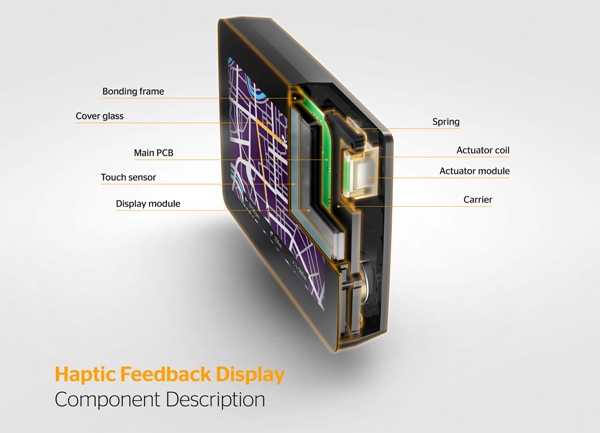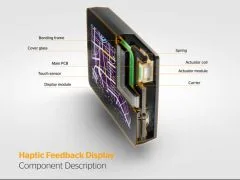Continental has released the Haptic Feedback Display for use in automotive applications. This display combines full touch capability with haptic feedback for the first time, the company claims in its latest press release.
This solution differs from other haptic solutions in that it uses a mechanical force to move the complete display module once a touch is detected.
With touch panels becoming the norm in modern cars, the use of smart and programmable buttons allows the car makers to add more functionality to their infotainment systems. For example, the same screen can control navigation, entertainment, climate and other controls. However, this requires the user to navigate menus on the touch screen and the only way the user can be sure if his interaction was successful is to look at the screen.This takes the driver’s eye off the road for seconds at a time.
As Continental describes this new haptic technology, it allows the driver to take his eyes off the touch display a split second earlier and return his attention to the road, as the driver receives a haptic feedback confirming his actions on the touch screen.
 Source: Continental
Source: Continental
The solution is based on a standard touch display for the automotive applications with an actuator mounted behind the complete display unit. The demonstrator display unit is based on an eight inch (20cm) display with full touch capability. Continental also thinks that displays with up to 12.3″ (30cm) size are technically feasible.
The impulse created by the actuator coil produces a deflection of only 0.1 mm, not visible to the naked eye. However, based on the high acceleration, the mechanical impulse can be easily felt by the finger. Continental states that the haptic feedback can be configured to the specification of the respective OEM.
The system allows the user of the haptic feedback system to run a finger over the display and ‘find buttons’ when the the tactile feedback is triggered. This would also allow the user to differentiate between two virtual buttons without looking at the display. A touchpad solution with haptic feedback is already offered by Continental and used in an optional feature in the latest Mercedes C-Class models. In this case, the haptic system is mounted behind a touchpad without a display.
Continental states that the new display system will be ready for series production in 2017.
Analyst Comment
This approach will certainly work for all displays in a car but allows only one haptic feedback for the whole screen. If a more detailed haptic response is required, like forming keys on a virtual keyboard, other haptic technologies may be better suited. It seems that this is another solution that may work well in an automotive application. – NH

